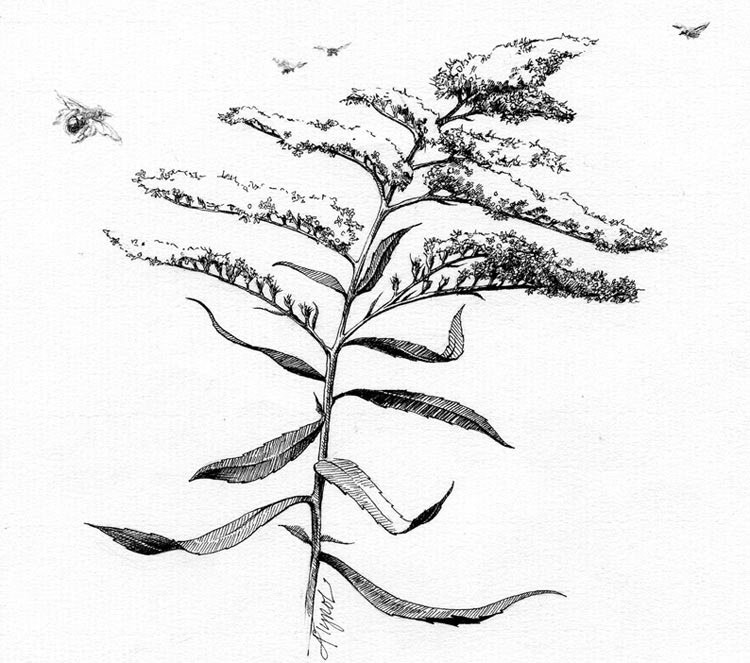
Where I live, the three warmer seasons are colored gold. In mid-May, the fields are covered with dandelions. Then come the buttercups, which turn the landscape into a real-life Monet painting. Now, as summer turns to fall, goldenrods.
These members of the aster family love old fields, and even in active fields where hay is harvested, they stand tall around the edges, glowing in the sun as the days grow shorter and the wind picks up bite. You’ll find them along dirt roads, on highway medians, and edging the forest. Because they're not shy, goldenrods get blamed for causing allergies. In fact, the culprit is generally ragweed, whose billions of light pollen grains float on the wind. Goldenrod pollen is heavy and spread by insects – especially by my honeybees.
To a beekeeper, a good goldenrod nectar flow is nature's late-summer gift. It can help ensure that bees have enough honey stores to survive the winter and, in a good year, provide the beekeeper with some to put on his toast. Goldenrod nectar ripening in a hive gives off a strong odor. The honey is darker than the lighter summer honeys and tends to crystallize rapidly. Interestingly, not all goldenrods are equally attractive to bees.
Bumblebees, beetles, flies, moths, and butterflies also feast on goldenrod, and in turn, wasps, beetles, spiders, and birds prey on the insects attracted to the yellow-topped stalks. There's even a goldenrod spider, named for itspreference for the plant as its hunting ground.
This time of year, it seems like goldenrod can be seen just about everywhere, and it’s no wonder, with 70 species in North America, 25 of which can be found in New England, according to Arthur Haines, research botanist for the New England Wild Flower Society.
The U.S. Department of Agriculture's Plant Database distribution map for goldenrod shows a completely filled-in map of the U.S. and Canada, from Baffin Island to the Virgin Islands to Hawaii. There are goldenrods that grow in the salt air on seaside dunes (seaside goldenrod), on tops of high mountains (alpine goldenrod), in arctic tundra (Rocky Mountain goldenrod), in bogs (bog goldenrod), in fields (too many species to mention). There's even one that grows in woods (wood goldenrod). There are goldenrods in Mexico and South America, Europe, and Asia, some of which are exotic invasives imported from North America.
With so many species, identifying goldenrods can be frustrating. On a recent September morning, I waded into the field across the road, armed with what I thought was a perfectly adequate wildflower guide. After 20 minutes, I figured out there were four or five different species in that sea of yellow, but I wasn't able to definitively identify any single one. “It's hard for people to use amateur guides to identify goldenrods,” said Haines. “But if you spent an hour learning the terminology, had good optics to magnify things, and a good measurement tool, you'd walk away with a different opinion.”
Solidago, goldenrod's Latin name, means “becoming whole,” a reference to the plant's numerous medicinal uses. Native Americans boiled the leaves and stems to make a tonic to bathe wounds and rashes. Elsewhere, people used goldenrod to treat everything from bladder infections to kidney stones, sore throats to tuberculosis. Canada goldenrod, a common species in Vermont and New Hampshire, “is a urinary tract antiseptic and anti-inflammatory,” Haines said. “It has a great role in treating urinary tract infections. It's something I have shared with a number of different people who say that it works, always, all the time.” And it's easy: dry the flowers and leaves and make a tea of them.
Goldenrod was traditionally used to make a beautiful yellow dye. The leaves also contain rubber and there were once efforts (by Thomas Edison, no less) to breed goldenrod for rubber production. It never went anywhere because the rubber quality wasn't good enough for tires.
Gardeners are keen on goldenrod as well. Flower hybridizers have taken the native goldenrods and created new cultivars with showier blooms. They are, however, all yellow. A plus for the northern gardener: they're hardy. A minus: some cultivars can take over your flower bed faster than you can spell rhizome, which is not surprising considering the fact that goldenrods are colonizers of disturbed areas, and a nicely tilled garden is just that.
While they’re an aggressive plant, it’s comforting to know that unlike many of the exotics you see blooming in a fallow field, goldenrod was here long before we were. “I can't think of a single non-native goldenrod that grows in this part of the world,” Haines told me.

